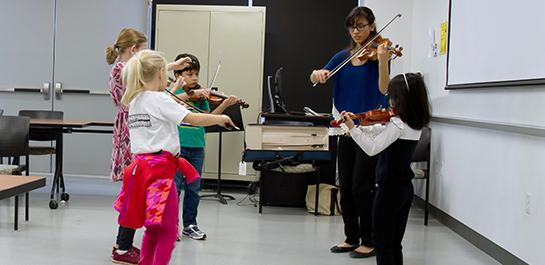Violin Adventures is a supplemental group class for students ages 5-12 who are enrolled in regular weekly private lessons, either at the Academy or in another studio. Teaching Artist Claire Allen describes seven ways that Violin Adventures benefits young students. The Spring 2018 class session starts next Saturday, January 27th, so come on board today!
 Academy Violin Teaching Artist Claire Allen has been presenting the Violin Adventures classes for several years, in both Fall and Spring semesters. Currently, the classes are held on Saturday mornings (usually alternating every other Saturday) in the Performing Arts Building on the Mason campus. Ms. Allen believes strongly that group learning experiences mixed with the standard private lessons are essential for a well-rounded and successful music student, and the following is her list of 7 beneficial elements of Violin Adventures:
Academy Violin Teaching Artist Claire Allen has been presenting the Violin Adventures classes for several years, in both Fall and Spring semesters. Currently, the classes are held on Saturday mornings (usually alternating every other Saturday) in the Performing Arts Building on the Mason campus. Ms. Allen believes strongly that group learning experiences mixed with the standard private lessons are essential for a well-rounded and successful music student, and the following is her list of 7 beneficial elements of Violin Adventures:
- Reinforcement of Violin Fundamentals
Every class begins with basic warm-up exercises and reminders about correct posture, violin balance, and bow hold. In addition to the extra reminders from the teacher, doing these exercises in a group setting allows students to observe their peers. Working together to create beautiful technique and seeing the posture of their classmates can be much more effective than teacher or parental reminders!
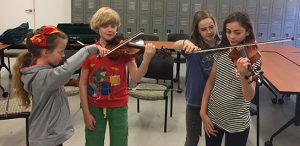
- Development of Listening and Ensemble Skills
Playing music with others is the most important thing we do as violinists. In a recital, we play with the pianist. In an orchestra or chamber group, we play with other string players. Practicing how to play together – which includes listening to the other players, breathing together, and focusing on making a beautiful sound as a whole – is crucial for the development of a successful violinist.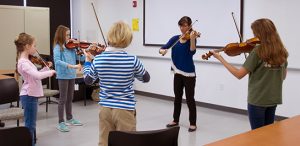
Photo by Alice Grabowski, Blue Green Photos - Incorporating Fun
Having a group of kids who love violin means that we get to play lots of games! We use review pieces from the Suzuki Method to play memory games such as the Vanishing Note Game (where we pick one note to leave out of the piece), or silly games such as Hide The Rosin (we hide someone’s rosin in the room, then play louder or softer to help them try to find it). One of my favorite games is to create a treble cleff and staff on the floor using tape so that we can play Musical Note Twister. The students have a blast as they work on their note-reading skills. These are just a few examples of the games we play in group class that we don’t get to do in private lessons.
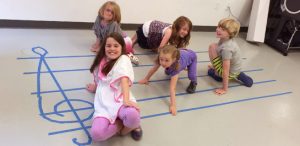
- Motivation through Peer Interaction
Kids in group class tend to practice more and are more motivated to continue their lessons. They look forward to seeing their friends in class and at recitals, and they also work harder to keep up with their classmates!
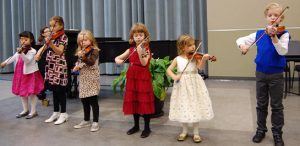
- Building Friendships
One of my favorite things over the course of the group class semester is seeing the friendships that form among the students. They go from being polite and shy during the first class to giggling, telling jokes, and hugging each other goodbye during the last class. As a musician myself, I can tell you that some of my closest and most important friendships are with fellow musicians who understand that part of me. Being a musician is a really special thing, and having the opportunity to make friends with other people who share that is vital.
Photo by Alice Grabowski, Blue Green Photos - Creating Confident Performers
Every class, we have “Solo Time,” which gives students the opportunity to perform their solo piece for a small, friendly audience. They practice walking to the front of the room and taking a bow before each performance. With an average of 8-10 classes in a session, this means that every student will get that many opportunities to do a practice performance before their end-of-semester recital. These students become more confident performers with every class!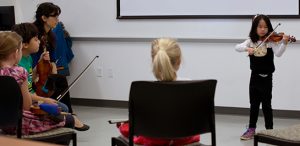
Photo by Alice Grabowski, Blue Green Photos - Providing Opportunity to Introduce Theory and History
Private lessons are packed with information about technique, how to practice, and learning new pieces. There’s simply not time to introduce more than the most basic concepts of music theory or history. Group class provides us with time to talk about harmony and chords, or to watch YouTube videos of famous performers. This also inspires and motivates the students, who always love getting to hear recordings. Depending on the age of students in the class, I may have them draw pictures, make up stories, or do a movement game along with the recording to engage multiple parts of their creativity.
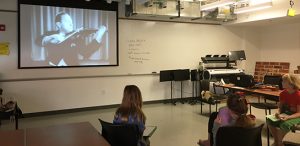
Here’s what parents and students have to say about their experiences in the class:
“Violin Adventures has been the perfect compliment to private lessons for my young daughter. It includes small ensembles, which you just can’t get by yourself in a lesson. She has formed wonderful friendships within the group with other kids her age who can relate to her violin experience.” – Jennifer, parent
“The group class is good opportunity to child to meet and talk other violinists who are about the same age and level. She gets motivation for playing violin and learning something from seeing other kids playing violin.” – Xuxing, parent
“I like to play violin together with the other violinists in the class. My favorite part is watching and listening to music on YouTube. I learned how to listen to other people for intonation.” – Vickie, violinist age 8
“I like that we do REALLY REALLY fun group pieces. My favorite part about the class is Solo Time because we get to hear everyone’s pieces that they are playing for a recital.” – Lindsey, age 10
Register now and let’s go on an adventure together!

